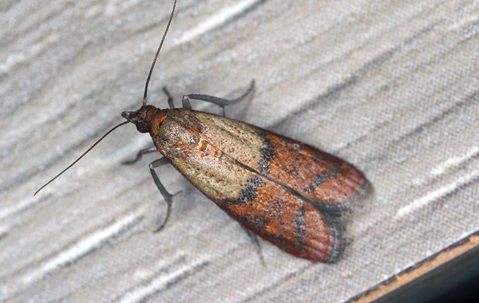When cooking, you need to get ingredients from the pantry fast. As the sauce simmers, you fling open the pantry door, grab the flour, and quickly rip open the paper container only to be greeted by moths! Suddenly, you feel sick and wonder how many other products are infested and ruined.
Don't risk ruining your next masterpiece! Secure the Peoria pest control team from Quik-Kill Pest Eliminators. Since 1929, we have been eliminating moths; we will stop moths from destroying food in your pantry.
How To Identify An Indian Meal Moth
When an insect scientist saw this type of moth eating corn meal, he decided to name it an Indian meal moth. When you see moths in pantry products, it is not adult moths; instead, it is the Indian meal moths in the larval stage. These newly-hatched Indian meal larvae have white heads on a 2/3 inch cloudy white body. Moths may remain at this stage of development for up to 41 weeks. After the moths complete this stage, they enter the pupa stage before becoming adult moths.
Although adult moths don't feed on pantry products, you will likely see them in the corners of the pantry. An adult Indian meal moth has a wingspan of 3/4 of an inch. The rear two-thirds of its wings are reddish-brown, the top one-third is grey-yellow, and a dark band separates the two sections. The head and thorax of the moth are yellow-brown with two antennae. When at rest, the six-legged Indian meal moth has a 1/2 to 5/8 inch elongated body.
How Pantry Moths Find Their Way Into Our Food
Light attracts adult Indian meal moths. If you keep exterior lights on at night, you will attract moths. If you have holes in window and door screens, moths can enter the house. Once inside the house, the moths can lay eggs, and the hatching larva will migrate into food products.
Another way an Indian meal moth infestation in the house begins is from contaminated packages brought into the home. Although the processing facilities use stringent detection techniques, packaged products with moth eggs occasionally pass inspection undetected. Products commonly infected by Indian meal moths include:
Grains
Seeds
Dried fruits
Chocolate
Powdered milk
Crackers
Nuts
Bird seed and dry pet food are two products often contaminated by Indian meal moths, and these products provide the perfect incubator for Indian meal moth eggs. If you see cream-colored small wormlike in the pantry or moths flying near lights, you have a moth problem in the house.
Four Simple Tips To Prevent Pantry Moths
Prevention is the best way to keep Indian meal moth nests out of your pantry. These four simple pest control tips will deter the moths from invading your pantry:
Purchase only products with no signs of damage.
Inspect grain and cereal products for Indian meal moths.
Transfer the product contents to an airtight plastic or glass container before storing them.
Eliminate products stored for more than four months, especially those in the original paper containers.
Good sanitation is a part of moth prevention. Wipe the shelves using soapy water; clean the corners of the ceiling, and vacuum the floor using a wand attachment to get any residual grain dust in the corners. If the pantry has a built-in light, restricting its use will avoid attracting other insects and moths.
The Best Way To Get Rid Of Indian Meal Moths In Your Home
The best solution to get rid of Indian meal moths is to use the professionals from Quik-Kill Pest Eliminators. When you schedule a free no-obligation inspection, we will come to your Peoria home, determine the scope of the infestation, and create a customized action plan. Contact our team today and let us eliminate the Indianmeal moths in your pantry.

